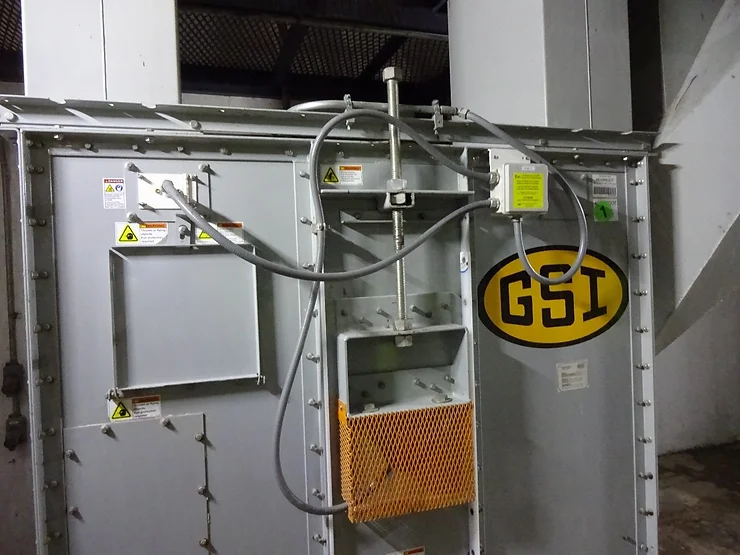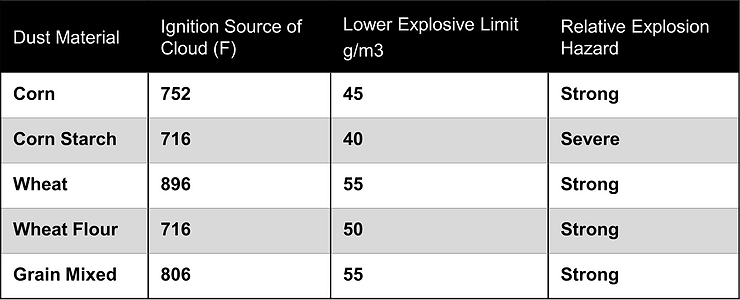GRAIN DUST EXPLOSION PREVENTION
 Hazard monitoring equipment can prevent grain dust explosions, save lives, and protect your facility from collateral damage. I have always referred to these systems as “cheap insurance.” The up-front investment pales in comparison to the impacts an explosion has on employees, facility infrastructure, and business interruption.
Hazard monitoring equipment can prevent grain dust explosions, save lives, and protect your facility from collateral damage. I have always referred to these systems as “cheap insurance.” The up-front investment pales in comparison to the impacts an explosion has on employees, facility infrastructure, and business interruption.
Ignition Sources
There are three primary ignition sources that can ignite suspended dust within the confinement of a bucket elevator. These ignition sources include heat generated by the belt slipping on the head pulley, the belt rubbing against the bucket elevator’s casing, and overheated bearings. Research indicates that the majority of grain dust explosions can be traced back to these three ignition sources.
Belt Slip
Belt slip occurs when the belt is loose or overloaded. It can only be detected by monitoring the speed directly from the belt or indirectly by monitoring the boot pulley rotations per minute (rpm). A 3-phase induction motor runs at a constant speed independent of its load. Therefore, a single sensor can be used to detect belt speed. The sensor is usually mounted by the boot pulley to detect the rpm of a target attached to the shaft or on the casing to detect the speed of the passing bucket’s bolts.
OSHA establishes requirements for belt speed detection in standard 1910.272 – Grain Handling Facilities. The standard requires employers to equip inside bucket elevators with a motion detection device that will shut down the bucket elevator when the belt speed is reduced by no more than 20% of the normal operating speed. An inside bucket elevator is a bucket elevator that has the boot and more than 20 percent of the total leg height (above grade or ground level) inside the grain elevator structure. Bucket elevators with leg casings that are inside of rail or truck dump sheds, with the remainder of the leg outside of the grain elevator structure, are not considered inside bucket elevators.
The OSHA requirement for belt speed detection does not apply to grain elevators having a permanent storage capacity of less than one million bushels, provided that daily visual inspection is made of bucket movement and tracking of the belt.
Belt Rubbing
Bucket elevators have sidewalls or casings that misaligned belts can rub against. Heat generated by the frictional rubbing can ignite dust inside the bucket elevator. Limit switches, brass rub blocks, optical sensors, non-contact sensors, and solid-state touch switches are used to detect improper alignment. OSHA standard 1910.272 – Grain Handling Facilities requires that inside bucket elevators be equipped with a belt alignment monitoring device which will initiate an alarm to employees when the belt is not tracking properly. Or, be equipped with a means to keep the belt tracking properly. The requirement for belt alignment monitoring does not apply to grain elevators having a permanent storage capacity of less than one million bushels. This is provided that daily visual inspection is made of bucket movement and tracking of the belt.
Bearings
Bearings create frictional heat when running. When properly lubricated, bearings usually run below the temperatures needed to ignite grain dust. If the bearing’s lubricant fails, heat can build up rapidly. This can ignite dust that has accumulated on or around the bearing or transfer heat to the interior of the bucket elevator. Bearing temperature monitoring systems monitor bearing temperature continuously. These systems consist of a bearing sensor mounted to the bearing housing and wired to an alarm control panel or programmable logic controller (PLC).

OSHA standard 1910.272 (link)
Grain Handling Facilities requires that bearings on inside bucket elevators be mounted externally to the leg casing. If this is not the case, the bearing must be equipped with temperature monitoring, vibration monitoring, or other means to monitor the condition of those bearings mounted inside or partially-inside the leg casing.
There are additional exceptions within the standard that negate the requirement for belt speed, belt alignment, and bearing temperature monitoring. One exceptions is for bucket elevators equipped with an operational fire and explosion suppression system capable of protecting at least the head and boot section of the bucket elevator. Another exception is when bucket elevators are equipped with pneumatic or other dust control system methods that keep the dust’s concentration inside the bucket elevator. The concentration inside the bucket elevator must be at least 25% below the lower explosive limit at all times during operation.
Today’s hazard monitoring systems can incorporate inputs from a number of different sensors such as belt speed, belt alignment, and bearing temperature. The system can be read from a wall mounted control panel, computer, and even a mobile phone app. Systems can also be interlocked to shut down the bucket elevator leg as well as upstream and downstream equipment. Hazard monitoring systems require regular preventive maintenance and inspection to ensure proper operation. The system should be tested in accordance with the equipment manufacturer’s requirements.
Conclusion
It is important that operations employees understand the purpose and importance of hazard monitoring equipment. It may save their life. Train employees to shut down equipment when the hazard monitoring system indicates a hazardous condition. Employees should also:
- refrain from bypassing or turning off the system,
- notify management if the system is not working correctly or damaged during housekeeping and maintenance activities, and,
- never disregard an alarm or hazardous condition.
Hazard monitoring systems are an effective means to prevent grain dust explosions. Many companies have expanded these systems to include exterior bucket elevators and interior/exterior conveyance. These systems provide a greater level of safety and a form of “cheap insurance.”
Related Links:
- Harvest Safety Strategies
- Combustible Dust in Agriculture and Processing Facilities
- Full Course Catalog – Safety Made Simple
Joe Mlynek is a partner and subject matter expert at Safety Made Simple, LLC. He has over 20 years of experience in safety at the corporate level and as a consultant. He is a Certified Safety Professional (CSP) and Occupational Safety and Health Technician (OHST). Joe can be reached at joe.mlynek@safetymadesimple.com
